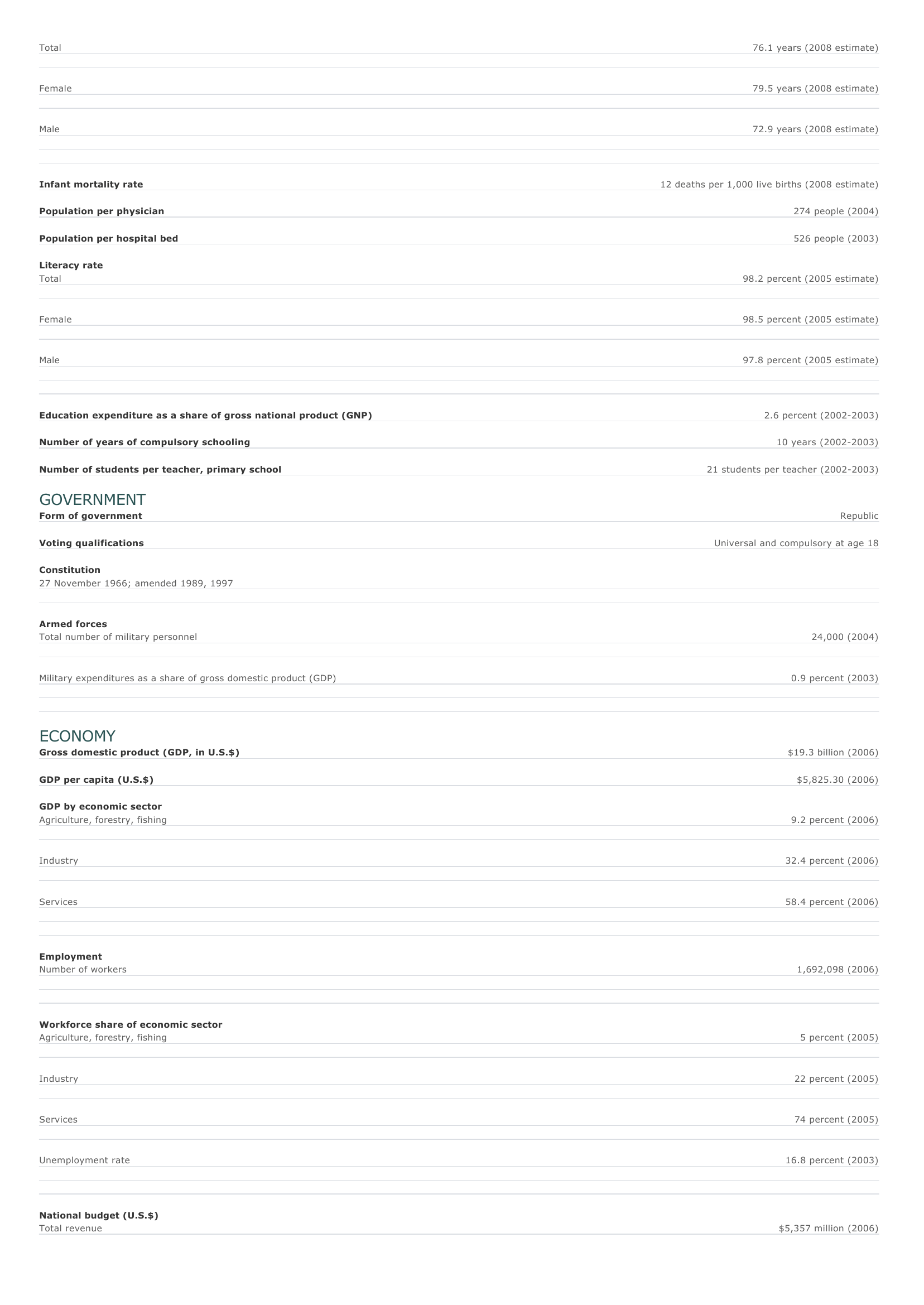
Uruguay Facts and Figures. BASIC FACTS Official name Capital Area Oriental Republic of Uruguay Montevideo 176,215 sq km 68,037 sq mi PEOPLE Population 3,477,778 (2008 estimate) Population growth Population growth rate 0.49 percent (2008 estimate) Projected population in 2025 3,715,772 (2025 estimate) Projected population in 2050 3,815,368 (2050 estimate) Population density Urban/rural distribution Share urban Share rural 20 persons per sq km (2008 estimate) 52 persons per sq mi (2008 estimate) 93 percent (2005 estimate) 7 percent (2005 estimate) Largest cities, with population Montevideo 1,347,888 (2005 estimate) Salto 99,072 (2004) P aysandú 73,272 (2004) Las Piedras 69,222 (2004) R ivera 64,426 (2004) Ethnic groups European descent 88 percent Mestizo 8 percent African descent 4 percent Languages Spanish (official) Religious affiliations Roman Catholic (less than half the adult population attends church regularly) 77 percent Protestant 2 percent Jewish 2 percent Other or nonreligious HEALTH AND EDUCATION Life expectancy 19 percent Total 76.1 years (2008 estimate) Female 79.5 years (2008 estimate) Male 72.9 years (2008 estimate) Infant mortality rate 12 deaths per 1,000 live births (2008 estimate) Population per physician 274 people (2004) Population per hospital bed 526 people (2003) Literacy rate Total 98.2 percent (2005 estimate) Female 98.5 percent (2005 estimate) Male 97.8 percent (2005 estimate) Education expenditure as a share of gross national product (GNP) Number of years of compulsory schooling Number of students per teacher, primary school 2.6 percent (2002-2003) 10 years (2002-2003) 21 students per teacher (2002-2003) GOVERNMENT Form of government Republic Voting qualifications Universal and compulsory at age 18 Constitution 27 November 1966; amended 1989, 1997 Armed forces Total number of military personnel Military expenditures as a share of gross domestic product (GDP) 24,000 (2004) 0.9 percent (2003) ECONOMY Gross domestic product (GDP, in U.S.$) GDP per capita (U.S.$) GDP by economic sector Agriculture, forestry, fishing $19.3 billion (2006) $5,825.30 (2006) 9.2 percent (2006) I ndustry 32.4 percent (2006) Services 58.4 percent (2006) Employment Number of workers 1,692,098 (2006) Workforce share of economic sector Agriculture, forestry, fishing 5 percent (2005) I ndustry 22 percent (2005) Services 74 percent (2005) Unemployment rate 16.8 percent (2003) National budget (U.S.$) Total revenue $5,357 million (2006) Total expenditure $5,260 million (2006) Monetary unit 1 peso uruguayo, consisting of 100 centésimos Major trade partners for exports Brazil, Argentina, United States, China, and Germany Major trade partners for imports Argentina, Brazil, United States, Venezuela, and France ENERGY, COMMUNICATIONS, AND TRANSPORTATION Electricity production Electricity from thermal sources Electricity from hydroelectric sources Electricity from nuclear sources Electricity from geothermal, solar, and wind sources 0.53 percent (2003 estimate) 99.06 percent (2003 estimate) 0 percent (2003 estimate) 0.41 percent (2003 estimate) Number of radios per 1,000 people 603 (1997) Number of telephones per 1,000 people 291 (2005) Number of televisions per 1,000 people 531 (2000 estimate) Number of Internet hosts per 10,000 people 257 (2003) Daily newspaper circulation per 1,000 people 296 (1996) Number of motor vehicles per 1,000 people 174 (1997) Paved road as a share of total roads 90 percent (1999) SOURCES Basic Facts and People sections Area data are from the statistical bureaus of individual countries. Population, population growth rate, and population projections are from the United States Census Bureau, International Programs Center, International Data Base (IDB) (www.census.gov). Urban and rural population data are from the Food and Agriculture Organization (FAO) of the United Nations (UN), FAOSTAT database (www.fao.org). Largest cities population data and political divisions data are from the statistical bureaus of individual countries. Ethnic divisions and religion data are largely from the latest Central Intelligence Agency (CIA) World Factbook and from various country censuses and reports. Language data are largely from the Ethnologue, Languages of the World, Summer Institute of Linguistics International (www.sil.org). Health and Education section Life expectancy and infant mortality data are from the United States Census Bureau, International Programs Center, International database (IDB) (www.census.gov). Population per physician and population per hospital bed data are from the World Health Organization (WHO) (www.who.int). Education data are from the United Nations Educational, Scientific and Cultural Organization (UNESCO) database (www.unesco.org). Government section Government, independence, legislature, constitution, highest court, and voting qualifications data are largely from various government Web sites, the latest Europa World Yearbook, and the latest Central Intelligence Agency (CIA) World Factbook. The armed forces data is from Military Balance. Economy section Gross domestic product (GDP), GDP per capita, GDP by economic sectors, employment, and national budget data are from the World Bank database (www.worldbank.org). Monetary unit, agriculture, mining, manufacturing, exports, imports, and major trade partner information is from the statistical bureaus of individual countries, latest Europa World Yearbook, and various United Nations and International Monetary Fund (IMF) publications. Energy, Communication, and Transportation section Electricity information is from the Energy Information Administration (EIA) database (www.eia.doe.gov). Radio, telephone, television, and newspaper information is from the United Nations Educational, Scientific and Cultural Organization (UNESCO) database (www.unesco.org). Internet hosts, motor vehicles, and road data are from the World Bank database (www.worldbank.org). Note Figures may not total 100 percent due to rounding. Microsoft ® Encarta ® 2009. © 1993-2008 Microsoft Corporation. All rights reserved.








